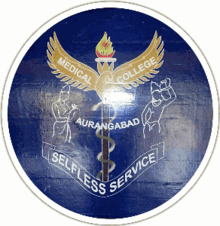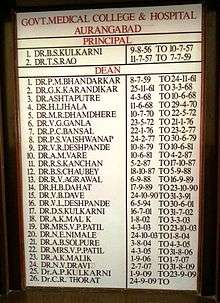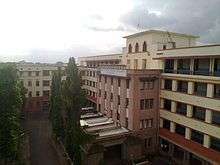Government Medical College (Aurangabad)
| Marathi: शासकीय वैद्यकीय महाविद्यालय व रुग्णालय, औरंगाबाद | |
 Official Logo of GMCH Aurangabad | |
| Motto | Selfless service |
|---|---|
| Type | Education and research institution |
| Established | 1956 |
| Endowment | Government Funded |
| Dean | Dr Chandrakant Mhaske |
| Undergraduates | 150 per year |
| Postgraduates | 81 per year |
| Location | Aurangabad, Maharashtra, India |
| Campus | 99 acres (0.4 km2) |
| Nickname | Ghati |
| Affiliations | Maharashtra University of Health Sciences, Nashik |
| Website | http://www.gmcaurangabad.com/home.html |
The Government Medical College (GMC) & Hospital (GMCH), Aurangabad (Marathi: शासकीय वैद्यकीय महाविद्यालय व रुग्णालय, औरंगाबाद) is a medical school affiliated to the Maharashtra University of Health Sciences (MUHS), Nashik.[1] The College is recognized by the Medical Council of India (MCI), New Delhi for medical education in India.[2] Founded in 1956 it is one of the premier medical institutions in the state of Maharashtra. At present, the college accepts 150 students per year for the undergraduate course MBBS and around 85 students per year for the various postgraduate courses.[3] The college has an excellent training centre for young medical aspirants like doctors, nurses and Bachelor of Para medical Technology (BPMT) students in the science of medicine.
Location
The college is located on the east bank of Kham river in northwest part of Aurangabad city, very close to famous tourist attractions like Panchakki, Bibi Ka Maqbara and Dr. Babasaheb Ambedkar Marathwada University. The college is 4 km away from the Aurangabad Railway Station,1.5 km away from the central bus stand and 11 km away from the Chikkalthana Airport.
History
The college was established on 15 August 1956, on the occasion of the 10th independence day of India. The college was started with 50 undergraduate students in a small Nizam Bungalow in the cantonment area of the city while infectious, obstetrics & ophthalmology wards were located at Amkhas in the other part of the city. The foundation stone for the present main building of the medical college was laid down by then chief minister of Bombay State, Yashwantrao Chavan, in presence of Swami Ramanand Teerth, on 27 October 1957. The building was inaugurated by Sushila Nayyar, then Minister of Health, Government of India, on 20 June 1964. Various other buildings were added to the campus over a period of time. For initial few batches, after completing the first year in the college students had to go to Government Medical College, Nagpur, to complete their second and final year of MBBS curriculum. From its inception till 1963, the college was affiliated to Osmania University, Hyderabad. After 1963, it was affiliated to the newly formed Marathwada University (now Dr. Babasaheb Ambedkar Marathwada University) located at Aurangabad. And since 1998, the college is affiliated to MUHS, Nashik, a centralized health university for health education in the state of Maharashtra.
The admission strength of college was subsequently increased to 100 undergraduate students per year and now it is allowed to take 150 MBBS students per year. Similarly, post graduation seats were added to various departments of the college; the current intake capacity is 85 post graduate students per year.[4] The college & hospital complex now consists agglomeration of 30 buildings spread over 99 acres. The hospital of the college started with 300 beds in a small Nizam Bungalow in 1960 is now equipped with 1170 beds distributed across various departments and wards.[5][6]
The college has been providing medicinal services to the people of Marathwada region and surrounding districts of Vidarbha and Khandesh regions round the clock for the last 55 years.
Past Principals of the Institute

| Sl. No | Name | Start date of term | End date of term |
|---|---|---|---|
| 1 | Dr. B.S. Kulkarni | 9 August 1956 | 10 July 1957 |
| 2 | Dr. T.S. Rao | 11 July 1957 | 7 July 1959 |
Past Deans of the Institute
| Sl. No | Name | Start date of term | End date of term |
|---|---|---|---|
| 1 | Dr. P.M. Bhandarkar | 8 July 1959 | 24 November 1961 |
| 2 | Dr. G.K. Karandikar | 25 November 1961 | 3 March 1968 |
| 3 | Dr. Ashthaputre | 4 March 1968 | 10 June 1968 |
| 4 | Dr. H.I. Jhala | 11 June 1968 | 29 April 1970 |
| 5 | Dr. M.R. Dhamdhere | 10 July 1970 | 22 May 1972 |
| 6 | Dr. V.G. Ganla | 23 May 1972 | 21 January 1976 |
| 7 | Dr. P.C. Bansal | 22 January 1976 | 23 February 1977 |
| 8 | Dr. P.S. Vaishwanap | 24 February 1977 | 30 June 1979 |
| 9 | Dr. V. R. Deshpande | 10 August 1979 | 10 June 1981 |
| 10 | Dr. A.M. Vare | 10 June 1981 | 4 February 1987 |
| 11 | Dr. R. S. Kanchan | 5 February 1987 | 17 October 1987 |
| 12 | Dr. B.S. Chaubey | 18 October 1987 | 5 September 1988 |
| 13 | Dr. R.V. Agrawal | 6 September 1988 | 16 September 1989 |
| 14 | Dr. H.B. Dahat | 17 September 1989 | 23 October 1990 |
| 15 | Dr. V.B. Dave | 24 October 1990 | 31 March 1991 |
| 16 | Dr. V.L. Deshpande | 6 May 1994 | 30 June 2001 |
| 17 | Dr. D.S. Kulkarni | 16 July 2001 | 31 July 2002 |
| 18 | Dr. A.K. Malik | 1 August 20002 | 3 March 2003 |
| 19 | Dr. Mrs. V. P. Patil | 4 March 2003 | 23 October 2003 |
| 20 | Dr. N.E. Nimale | 24 October 2003 | 1 August 2004 |
| 21 | Dr. A.B. Solpure | 3 August 2004 | 4 March 2005 |
| 22 | Dr. Mrs. V. P. Patil | 4 March 2005 | 31 August 2006 |
| 23 | Dr. A.K. Malik | 1 September 2006 | 1 July 2007 |
| 24 | Dr. N.V. Dravid | 2 July 2007 | 31 August 2009 |
| 25 | Dr. A.P. Kulkarni | 1 September 2009 | 23 September 2009 |
| 26 | Dr. C.R. Thorat | 24 September 2009 | |
| 27 | Dr. C. B. Mhaske | Incumbemt |
Academics
The courses offered by the institute are:
- M.B.B.S. (Annual intake of 150 students)
- M.D./M.S.
- B.Sc. in Nursing (Annual intake of 50 students)
- Diploma Course in Medical Laboratory Technology (DMLT)
- Bachelor of Para medical Technology (BPMT)
The graduates from the institute are highly placed & are catering medical services in various fields in India & abroad.
Admissions
Undergraduate courses
The GMC, Aurangabad accepts 150 students every year for MBBS course. The admission is based on merit in the MHT-CET. But for academic year 2013-2014, it was based on merit in the National Eligibility cum Entrance Test.[4]
The college has 120 BPMT student intake. The BPMT course is for the posts of lab technician, radiology technician, radiotherapy technician, community and medicine technician etc.
Post-graduate courses
The post-graduate students in various courses of medicine and surgery get admitted to GMC through all India and Maharashtra state level post-graduate medical entrance examinations.
Medical services
The special facilities available at GMCH, Aurangabad include Intensive Care Unit (ICU), Intensive Coronary Care Unit (ICCU), Medicine Intensive Care Unit (MICU), Neonatal Intensive Care Unit (NICU), Paediatric Intensive Care Unit (PICU), CT scan, MRI and a blood bank amongst other facilities. It is backed up by Central & Departmental Laboratories for all the investigations round the clock.
To provide a quality healthcare for people in rural area, the Preventive and Social Medicine (PSM) department of GMC operates one rural health and training centre at Paithan 50 km from Aurangabad. The PSM department also operates one urban healthcare centre in the Shahganj area of Aurangabad.
Speciality care centres at GMCH
The super-speciality care centres at GMCH include
- Cardiology and Cardio-thoracic Intensive Care Unit
- Radiotherapy Centre[7][8]
- Government Cancer Hospital[9]
- Telemedicine Centre[10][11]
Research at GMCH
Both non-clinical and clinical departments of the GMCH are involved in active research in number of fields. Faculty and students of the GMCH have their research papers published in number of national and international journals.[12][13][14][15][16][17]
Sandfly fever, an aroboviral disease is known to occur in the arid regions of West Pakistan and Middle East. Its occurrence in India was thought to be doubtful. However, in 1967, the sandfly fever virus was isolated in Aurangabad from febrile cases.[18]
Residential facilities
The GMC provides residential facility for all its faculty members, staff and students inside the campus. There are two hostels for male undergraduate students (Old and New Boys Hostel), a single hostel for female undergraduate students and a separate hostel for Nursing students.[3] Post-graduate students have a separate residential block. The quarters for nursing and other staff are also located inside the campus.
Campus

- College & hospital buildings: The GMCH is spread over 40 hectare (99 acres) of land. The main administrative and teaching building of college is a four story tall building; built in colonial style with red stones, stone pillars and broad doorways. The main building contains various offices on ground floor, Dean's office on first floor, number of lecture theaters, anatomy museum, pathology museum, PSM museum, canteen and an auditorium with seating capacity of 800. The other buildings in campus include Out Patient Block (OPD), Surgical and OBGY wards block, Medicine wards and Super-Speciality (Cardiology & CVTS) unit. Government Dental College which offers BDS degree is also located in the same premises.
- Library and Reading rooms: The College has a library with a good collection of medical text books, national and international journals of different faculties and various other referral books. Two separate reading rooms are available for undergraduate and post graduate students.
- Gymkhana: The College maintains a gymkhana to provide facilities for sports and recreation for students and faculty members inside the campus. The gymkhana includes table tennis court, badminton court and volleyball court.
See also
- Medical College (India)
- List of medical colleges in India
- Maharashtra University of Health Sciences,Nashik
References
- ↑ M.U.H.S. College Information
- ↑ MCI List of Colleges Teaching MBBS in India
- 1 2 Information from DMER Official website
- 1 2 GMC, Aurangabad Official Website
- ↑ "Yahoo Campus Information". Yahoo. Retrieved 3 November 2011.
- ↑ "घाटीतील चतुर्थ श्रेणीची १५७ पदे रिक्त". लोकमत (Marathi Newspaper). India. 24 September 2012. Retrieved 25 September 2012.
- ↑ Central Bureau Of Health Intelligence - India: LIST OF RADIATION THERAPY CENTRE
- ↑ "कोबाल्ट युनिटमध्ये कर्करुग्णांसाठी अनेक सुविधा". सकाळ (Marathi Newspaper). India. 11 December 2009. Retrieved 25 September 2012.
- ↑ "Govt hospitals gear up to tackle cancer". The Times of India. India. 5 February 2012. Retrieved 20 September 2012.
- ↑ Govt. of Maharashtra NHRM Website
- ↑ "With The Help Of Telemedicine, 11 Super-Speciality Hosps Reach Out To Doctors & Patients In Africa". The Times of India. India. 30 March 2010. Retrieved 18 September 2012.
- ↑ Ingle, A.; Patil, S.; Bindu, R.; Kulkarni, A.; Kumbhakarna, N. (2012). "Mucinous carcinoma of the male breast with axillary lymph node metastasis: Report of a case based on fine needle aspiration cytology". Journal of Cytology. 29 (1): 72–74. doi:10.4103/0970-9371.93228. PMC 3307461
 . PMID 22438625.
. PMID 22438625. - ↑ Damle, A.; Gaikwad, A.; Patwardhan, N.; Duthade, M.; Sheikh, N.; Deshmukh, D. (2011). "Outbreak of human buffalopox infection". Journal of Global Infectious Diseases. 3 (2): 187–188. doi:10.4103/0974-777X.81698. PMC 3125034
 . PMID 21731308.
. PMID 21731308. - ↑ Nillawar, A.; Bardapurkar, S. J.; Bardapurkar, J. S. (2012). "High sensitive C-reactive protein as a systemic inflammatory marker and LDH-3 isoenzyme in chronic obstructive pulmonary disease". Lung India. 29 (1): 24–29. doi:10.4103/0970-2113.92358. PMC 3276029
 . PMID 22345910.
. PMID 22345910. - ↑ Patil, S.; Deshmukh, D.; Dixit, J. V.; Damle, A. S. (2011). "Epidemiological investigation of an outbreak of acute diarrheal disease: A shoe leather epidemiology". Journal of Global Infectious Diseases. 3 (4): 361–365. doi:10.4103/0974-777X.91060. PMC 3249992
 . PMID 22224000.
. PMID 22224000. - ↑ Deshmukh, V. L.; Yelikar, K. A.; Deshmukh, A. B. (2011). "Comparative Study of Intra-cervical Foley's Catheter and PGE2 Gel for Pre-induction Ripening (Cervical)". The Journal of Obstetrics and Gynecology of India. 61 (4): 418–421. doi:10.1007/s13224-011-0063-2. PMC 3295881
 . PMID 22851824.
. PMID 22851824. - ↑ Kulkarni, S.; Kulkarni, S. (2011). "Use PEEP for treating capnothorax". Indian Journal of Anaesthesia. 55 (5): 550–552. doi:10.4103/0019-5049.89913. PMC 3237171
 . PMID 22174488.
. PMID 22174488. - ↑ Bhatt, P. N.; Dandawate, C. N.; Rodrigues, F. M.; Bhagwat, R. B. (1971). "Isolation of a virus belonging to the Phlebotomus fever virus group from febrile cases in Aurangabad". The Indian journal of medical research. 59 (10): 1633–1640. PMID 5003542.
External links
- GMC, Aurangabad Official Website
- Maharashtra University of Health Sciences, Nashik
- Directorate of Medical Education and Research, Maharashtra
- Medical Council of India